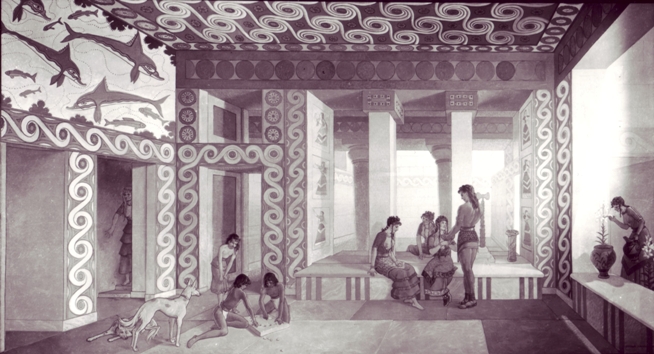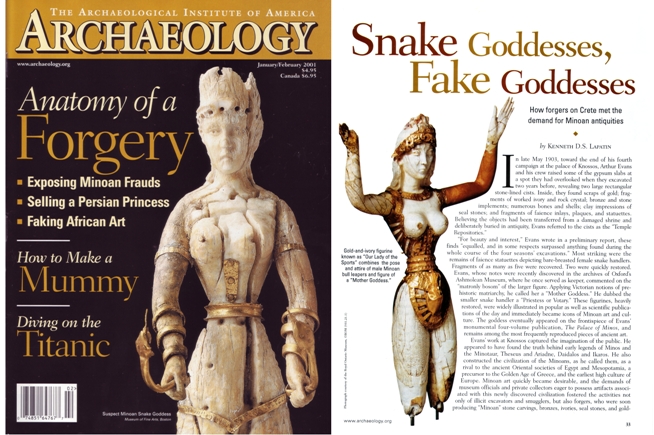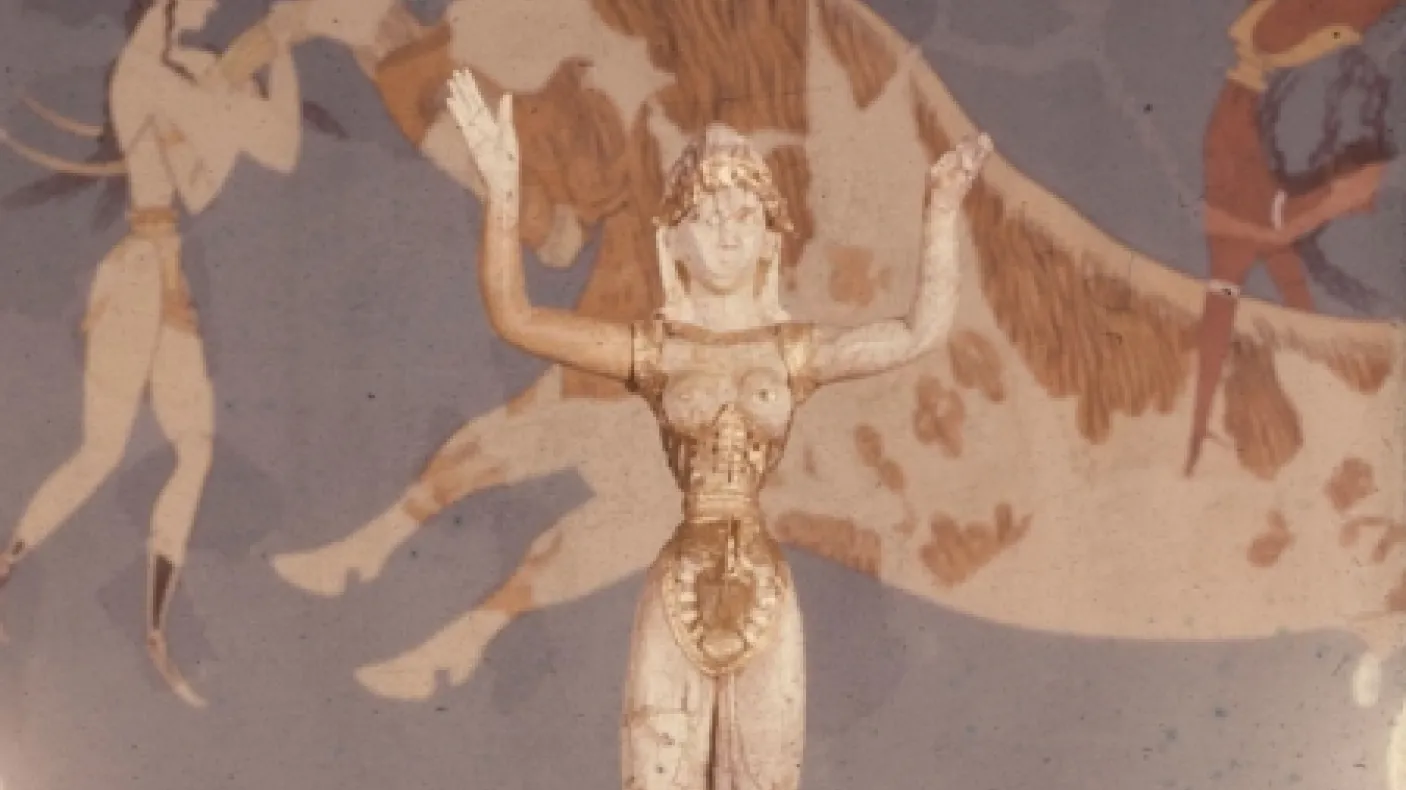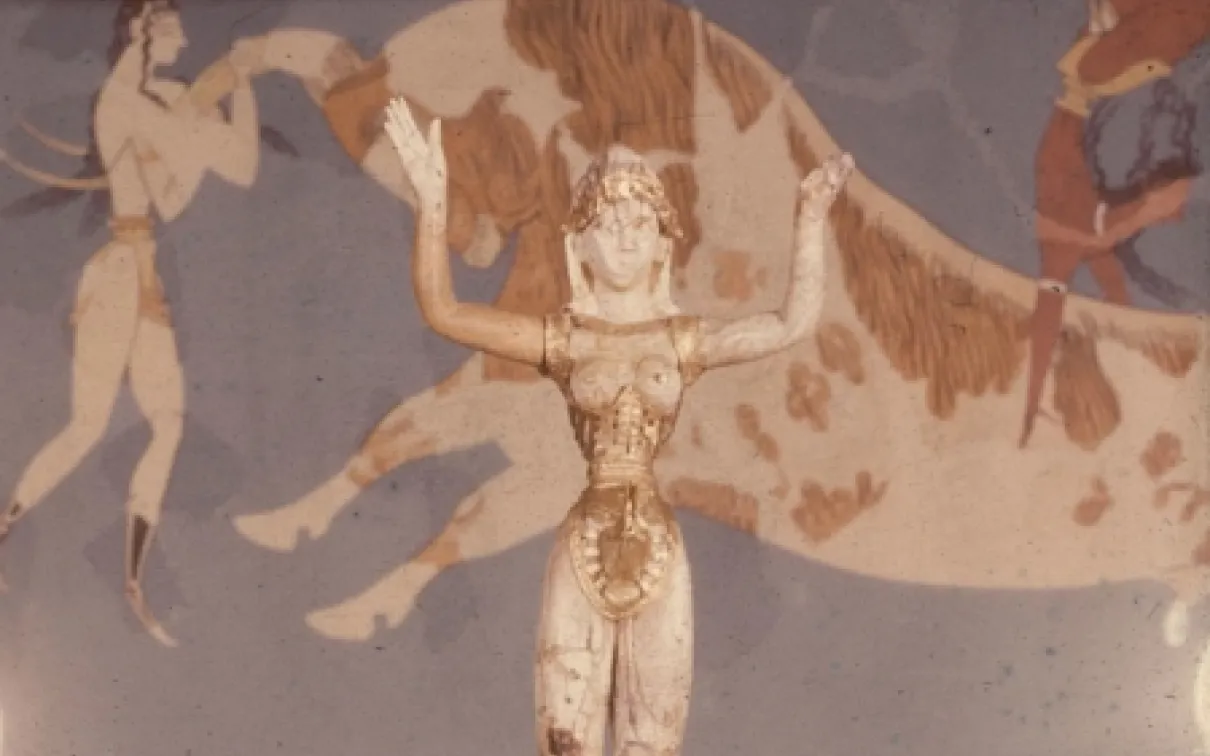The 'Goddess' and the Museum: Museum Attitudes
Published
Categories
Author

Blog Post
An old ROM photograph of the ‘Minoan’ ivory figurine on display in front of the watercolour reproduction by Piet de Jong of the Minoan Bull-Leaper fresco from Knossos
Photo: © ROM
Here I continue the story of an icon of the Royal Ontario Museum (ROM) collection: the ivory and gold female figurine–ROM 931.21.1. For further information see the ‘Minoan’ Ivory Goddess Research Project.
In 1931 the Museum had paid a huge sum for an object that would put the newly-established ROM on the map in the eyes of the international academic and museum community and the visiting public. Charles Trick Currelly (ROM Director 1914-1936) had ensured that the figure was authenticated by the foremost expert in Minoan culture, Sir Arthur Evans, and despite the doubts raised by others, he continued to believe the figure was a prized Minoan artefact, still maintaining that it was “one of our most important Classical acquisitions” (p.232) in his autobiography, I Brought the Ages Home, written in 1956.
The Museum took its lead from Currelly. From the moment it arrived in the museum, the ‘Minoan’ goddess held pride of place in the Greek gallery, hailed as one of the most attractive and important objects in the collection, and singled out for a special mention in ROM Gallery Guides:
“The most important pieces are the marble statues of Venus the Mother, and of Venus Genetrix; the gold and ivory statuette of a Cretan female bull-leaper, and the loutrophoros vase by Polygnotos.”
Guide to the Galleries of the Royal Ontario Museum, 1931, p.5
Despite the official Museum attitude, the wider academic community obviously had doubts, not because they had studied the figurine itself, but because there was no record of the object’s archaeological findspot. As Evans wrote in his 1931 article in the Illustrated London News, “All that it has been possible to ascertain about the provenance of the figure is that it had made its way from Crete, where it had been in private possession for a considerable number of years”. The figurine was compared to unprovenanced ‘Minoan’ figures in other museum collections, several of which were already considered fake. However, C. R. Wason (ROM Keeper of the Classical Collections 1931-1933), who published the figurine in the 1932 ROM Bulletin, was convinced that the goddess was authentic and declared that she “came from Knossos”. This claim to a provenance became part of ROM lore, repeated in labels and Museum publications, but it seems to be a fabrication (or misunderstanding). It had not been mentioned when the figurine was bought, nor was it repeated by Evans, excavator of Knossos, in his 1935 publication of the figurine in The Palace of Minos.
When the new wing of the Museum facing Queen’s Park was completed in 1933, the Greek collection moved into the new suite of galleries on the second floor, and objects from Cyprus and Bronze Age Crete were displayed in Gallery 3. The goddess took centre stage, surrounded by genuine Minoan artefacts and replicas of famous objects from the excavations on Crete. Notes made by the new curator Homer A. Thompson (ROM Keeper of the Classical Collections 1933-1947) show that he thoroughly investigated the figurine, probably because of the questions raised by Canadian newspapers in 1935 (see my previous article). He examined other Minoan artefacts for iconographic parallels and wrote to other museums that owned ‘Minoan’ goddesses, and he seems to have been satisfied that the figurine was authentic. She remained a star of the display, and gradually the Minoan civilisation was brought to life for Museum visitors with the addition of pictures on the walls of the gallery. Watercolour reproductions of some Minoan frescoes from the excavations at the palace of Knossos were bought in 1938 from Piet de Jong, an archaeological illustrator working in Greece. These included a copy of the famous Bull-Leaping Fresco, which was the best parallel for the costume worn by the ROM figurine. They were complemented by an imaginative vision of life inside the Palace at Knossos painted by Sylvia Hahn, ROM illustrator.
"…the gold and ivory statuette of a goddess in gallery 3, is attributed to the 16th century B.C., when the Island of Crete dominated the Aegean. It should be studied in conjunction with the reproduction of the mural of the bull-leaping hung on the north wall and with the restoration of a scene in contemporary palace life on the west wall of the same gallery.”
R.O.M. Some Points of Interest, 1942, p. 18

Palace of Minos, The Queen’s Apartments, painted by Sylvia. Hahn in 1940 for ROM Gallery 3
Few records survive for the time when Walter J Graham took over as Keeper of ROM’s Classical collection (1947-1966), and his attitude towards the ROM figurine is unclear. Graham specialised in Greek architecture and his 1962 book, The Palaces of Crete, devotes a whole chapter to the evidence for locating the Minoan bull-leaping spectacle in the grand central courtyard of palaces, such as that at Knossos. He makes no reference to the ROM figurine dressed as a bull-leaper, suggesting that he didn’t believe she strengthened his argument, but the goddess was still a centrepiece of the ROM gallery display. An unpublished inventory of the gallery from 1949 shows that, by then, the figurine was displayed alone in a purpose-made showcase.
By the 1960s the ROM’s attitude to the goddess was mixed. While she continued to be displayed as a Minoan artefact, requests to publish the piece in textbooks on Minoan life were refused, on the grounds that her authenticity had been questioned and she was “under study”. However, the figurine was selected for publication in Art Treasures of the Royal Ontario Museum:
“It is fitting that this section of museum treasures should be introduced with a figure as tiny and exquisite as it is celebrated, the solemn figure of a narrow-waisted woman – whether goddess or mortal is uncertain…She was reputedly found at Knossos and is to some eyes the most beautiful of several related pieces. All of these have been doubted in the past, and the debate continues. Our goddess or priestess remains mute on the subject and meanwhile reigns in serene majesty over the gallery devoted to Minoan and archaic Greek art.”
T.A. Heinrich, Art Treasures of the Royal Ontario Museum, 1963, p. 90
In the early 1970s Neda Leipen (ROM Curator in Charge of the Greek and Roman Department 1967-1986) tried to resolve the question by again asking for expert opinions. She was herself something of an expert on ancient ivory and gold statues, after researching the Classical ivory and gold statue of Athena Parthenos by Pheidias from the Parthenon on the Athenian Acropolis. She was obviously reluctant to condemn the figurine as a fake, and this opinion seemed to be cautiously supported by two other experts. After examining the goddess at the ROM in 1971, Sinclair Hood (director of British excavations on Crete), who had uncovered some Minoan ivory figurines at Knossos in 1957-1961 excavations at Knossos, said:
“I could not fault the left arm of your figure, and if it appeared in an excavation it would not surprise me. Indeed the ivory in general is difficult to my mind to fault, although the way the hair is cut at the back worries me…”
letter from S. Hood to N. Leipen 31st March, 1971
After studying photographs, Efi Sakellarakis-Sapouna, a Greek archaeologist working with other genuine Minoan ivory figurines from Cretan excavations, concluded:
“The hips are really ‘Minoan’…Other details, like arms, look also very Minoan. On the contrary the face doesn’t seem very ‘Minoan’ and that is why I am hesitating to characterize it as genuine…of course the future excavation could reveal Minoan ladies with faces like hers.”
letter from E. Sakellarakis to N. Leipen 16th February, 1972
The general scholarly consensus was that the circumstances of acquisition and the general style of the ROM goddess associated her with two other unprovenanced gold and ivory ‘Minoan’ goddess figurines – the ‘Boston goddess' acquired by the Museum of Fine Arts in 1914, and the ‘Baltimore goddess' acquired by the Walters Art Museum in 1931. It is ironic that the very association with the Boston goddess that made the Museum so eager to buy the ROM goddess in 1931 (see my previous), should serve to cast doubt on her decades later.
In 1991 John Bowman, a travel writer about Crete, began a series of articles for a newsletter called Museum Insights, about one of his favourite ancient artefacts, the Boston snake goddess. What he believed would be a story about unethical collecting practices by a major US museum in the early 20th century, turned into an exposé of the Boston goddess as a probable fake, when the story of the acquisition fell apart under examination. He then moved on to consider the other gold and ivory ‘Minoan’ figurines in North America – the Baltimore and ROM goddesses – concluding that they too were dubious, and that their gold costumes were modern additions.
“I am now prepared to claim that the goldwork on these three statuettes is a modern addition. I remain bothered by the faces, and I would not be at all surprised if a close technical analysis of the ivory revealed that there has been some modern reworking…”
J. Bowman, ‘A North American School of Minoan Art’ Museum Insights 4.2, 1992
This was not due to any new evidence, indeed Bowman had not even seen the ROM goddess in person, but it did give a public voice to the doubts that were picked by the Toronto Globe and Mail (‘The mystery of the bull leaper’ by Kate Taylor, May 14th, 1992). In fact, at just this time there was a growing scholarly interest in all the unprovenanced ‘Minoan’ goddess figures (all those in museums outside Crete). Several academics had contacted the Museum asking about the collection history of the ROM goddess, the ivory itself and the manufacturing techniques. Although the ROM figurine was too delicate to be analyzed by destructive Carbon-14 testing, it was carefully studied while being cleaned in the museum. The conclusion reached was that the weathering of the ivory showed that it was certainly old, and it had been carved while the ivory was still ‘alive’.

Kenneth Lapatin's article in Archaeology magazine, 2001
It wasn’t until 2001 that a sensational article by Kenneth Lapatin, a specialist in ancient ivory and gold statues, again raised the subject, condemning the Boston goddess, and all the other unprovenanced goddesses including the ROM figurine, as early 20th-century forgeries manufactured by the very workmen who were excavating with Arthur Evans at Knossos.
“Fashioned by skilled Cretan workmen of the early twentieth century A.D., rather than the mid-second millennium B.C., they offer valuable testimony to how scholarly interpretations and museum displays can be distorted by the desires of the present.”
K. Lapatin, ‘Snake Goddesses, Fake Goddesses’ Archaeology. January/February 2001, p. 36
This was picked up by the Canadian newspapers and ROM decided, for the first time, to change the labelling of the figurine in response to this accusation. It was an opportunity to highlight the debate which never before been reflected in the gallery presentation. The figurine remained on display, but its old label, reading:
BULL-LEAPER
Dubbed ‘Our Lady of Sports’ by Sir Arthur Evans, excavator of Knossos, Crete.
Gold and ivory. Minoan (MMIII), about 1600 B.C.
931.21.1
was joined by a copy of Lapatin’s article and an information panel:
In Search of the Truth
The collections of the Royal Ontario Museum are an important resource for researchers both within the museum and outside. Many differing theories result from these studies. As part of our on-going research into the authenticity of our gold-and-ivory statuette, nicknamed Our Lady of Sports, here we present the opinion of Dr. Kenneth Lapatin of Boston University. His article, “Snake Goddesses, Fake Goddesses”, recently appeared in Archaeology (January/February 2001).
Museum visitors were left to draw their own conclusions, and although several Museum staff still believed the goddess was ancient, she became infamous to many as a fake, condemned by association with the other figurines. The “on-going research” yielded no new evidence, and when the current Bronze Age Aegean gallery was created in 2005, the ROM goddess was not included. After more than six decades on display as one of the most iconic objects of ROM’s ancient Mediterranean collection, the goddess was consigned to the storeroom, only appearing occasionally as a famous fake.
In the last instalment of this investigation into the ROM archives, The Goddess and the Museum: “What’s in a name?”, I’ll be considering how the different interpretations of the goddess have helped to give her a lasting appeal.
Further Reading
C.L. Cooper (Kate Cooper), 'Biography of the Bull-Leaper: A 'Minoan' Ivory Figurine and Collecting Antiquity', in Cooper C.L. (ed) New Approaches to Ancient Material Culture in the Greek & Roman World (Leiden: Brill, MGR 27, 2021). doi:10.1163/9789004440753_005


